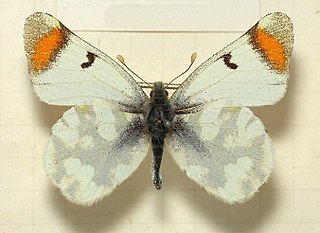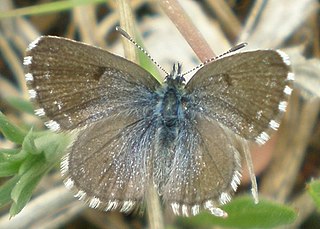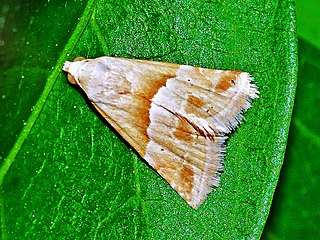
The green hairstreak is a small butterfly in the family Lycaenidae.

The purple hairstreak is a butterfly in the family Lycaenidae distributed throughout much of Europe, North Africa, Anatolia, Caucasia, and Transcaucasia. The larva feeds on Quercus robur, Quercus petraea, Quercus cerris and Quercus ilex.

The large tortoiseshell or blackleg tortoiseshell is a butterfly of the family Nymphalidae.

The sooty orange tip is a Palearctic Pieridae butterfly that has a range that extends through southern Europe, southwest Europe, northern Africa, East Kazakhstan and Asia Minor. Global warming currently seems to be extending its range to the north. The habitat consists of open flowery grasslands amongst hills.

Euchloe ausonia, the eastern dappled white, is a southern European and Palearctic butterfly found mostly to the south and east of its almost indistinguishable relative the western dappled white.

Pseudophilotes baton, the baton blue, is a butterfly of the family Lycaenidae. It is found in central and southern Europe and then east across the Palearctic to the Russian Far East.
Hecatera cappa is a species of moth of the family Noctuidae. It is found in Morocco, Algeria, central and south-eastern Europe, Turkey, Transcaucasia, Israel, Lebanon, Jordan, Iran and central Asia.

Agrotis trux, the crescent dart, is a moth of the family Noctuidae. The species was first described by Jacob Hübner in 1824. It has a circum-Mediterranean distribution and is found along the coasts of France, Ireland, England, southern Europe, Algeria, Syria, Iraq, Iran, southern Russia and the Arabian Peninsula. In Africa, it is found as far south as South Africa.

Cucullia argentina is a moth of the family Noctuidae. It is found from central Turkey throughout the Caucasus, Iraq, Iran, Turkmenistan, southern Russia, Kazakhstan and Afghanistan to Mongolia.

Muschampia mohammed, the Barbary skipper, is a butterfly of the family Hesperiidae. It is endemic to Morocco and Algeria. It is found in dry and flower-rich areas between 1,500 and 2,000 meters.

Calpodes ethlius, the Brazilian skipper, larger canna leafroller or canna skipper, is a butterfly of the family Hesperiidae. It is found in the United States from southern Florida and southern Texas, south through the West Indies, Mexico, and Central America to Argentina. Strays and temporary colonies can be found north to southern Nevada, northern Texas, Illinois and Massachusetts.

Sphingonaepiopsis gorgoniades, the Gorgon hawkmoth, is a moth of the family Sphingidae. The species was first described by Jacob Hübner in 1819. It is found from Croatia, Albania, Macedonia, central and southern Greece, eastern Bulgaria and Romania across southern Ukraine and the Crimea, southern Russia as far north as Kazan, the southern Urals and eastern Kazakhstan to Kyrgyzstan and Afghanistan. It has also been recorded from central and southern Turkey, Lebanon, Israel and western Jordan eastward across northern Iraq, the Caucasus, northern Iran to southern Turkmenistan.
Trifurcula pallidella is a moth of the family Nepticulidae. It is the type species of the genus Trifurcula. It is found from south-eastern Germany (Bayern), east into Bohemia, Moravia, Slovakia, adjacent south-eastern Poland, much of Austria, both along the Danube and east and south of the Alps, extending through the Balkans to southern Greece (Peloponnesus) and Crete, eastwards through Ukraine and Russia to the Volga, and one questionable record from Turkey. To the west it occurs in northern Italy almost reaching France, just extending into Switzerland (Ticino), and throughout Italy to Sicily and Corsica.

Hyles siehei is a moth of the family Sphingidae. It is known from southern and eastern Turkey, Armenia, northern Syria, northern Iraq and northern Iran. Then probably south along the Zagros Mountains of Iran to the Kerman Province. It is also known from lowland southern Kazakhstan, from the shores of the Caspian Sea across to the Chinese border, southern Uzbekistan and northern Turkmenistan.

Pseudophilotes panoptes, the Panoptes blue, is a butterfly of the family Lycaenidae. It is found on the Iberian Peninsula and in North Africa, including Morocco.

Agdistis adactyla is a moth species in the family Pterophoridae, and the type species of genus Agdistis. It is known from most of the Palearctic realm, where it occurs from central and south-western Europe and North Africa to eastern Asia.

Eublemma parva, the small marbled, is a moth of the family Erebidae. The species was first described by Jacob Hübner in 1808.

Pseudophilotes abencerragus, the false baton blue, is a butterfly in the family Lycaenidae. It is found on the Iberian Peninsula and in North Africa, Egypt, Israel, Jordan and Saudi Arabia.

Anthanassa texana, the Texan crescentspot, is a species of butterfly in the family Nymphalidae. It is found from Guatemala north through Mexico to southern California, east across the southern United States to northern Florida, Georgia and South Carolina. Strays may be found up to Arkansas, Missouri, Illinois, South Dakota, and central Nevada. The habitat consists of deserts, dry gulches, open areas, streamsides, road edges, and city parks.

Aethes bilbaensis is a species of moth of the family Tortricidae. It is found in Morocco, Algeria, the Iberian Peninsula, southern France, Italy, Croatia, Albania, Greece, Austria, the Czech Republic, Slovakia, Hungary, Romania, Bulgaria, Russia, Asia Minor, the Palestinian territories, Lebanon, Iran, Afghanistan, Pakistan, Kazakhstan, Kyrgyzstan and Turkmenistan. It is found in xerothermic habitats.

















